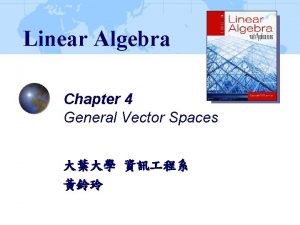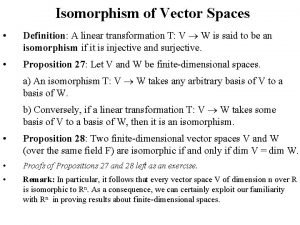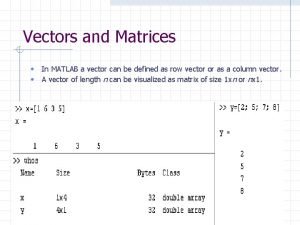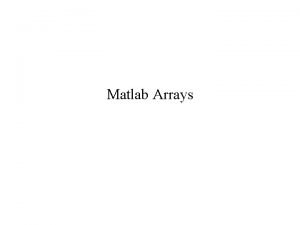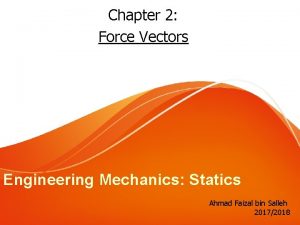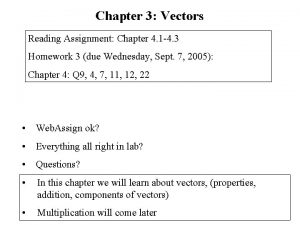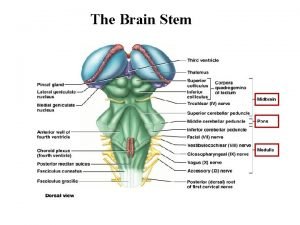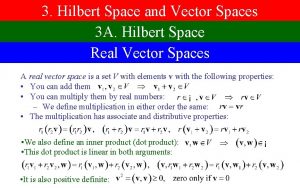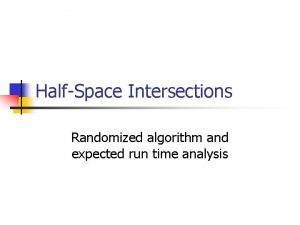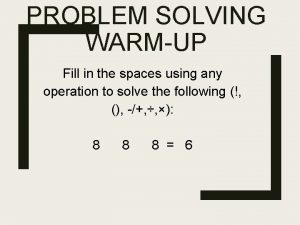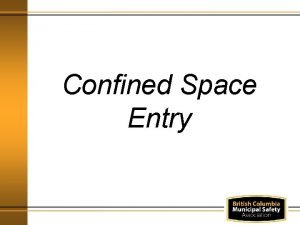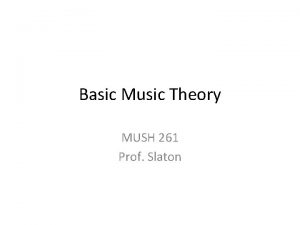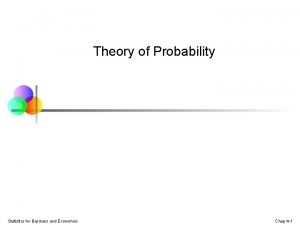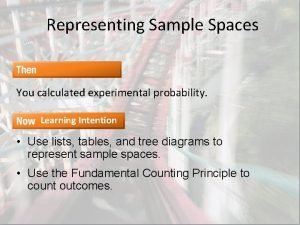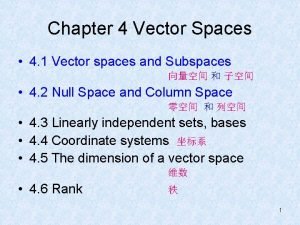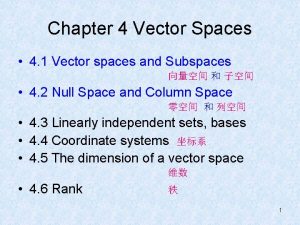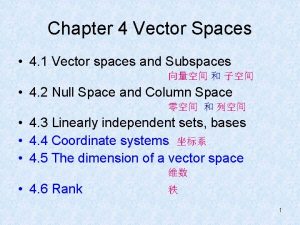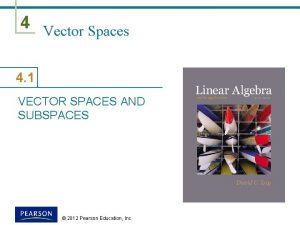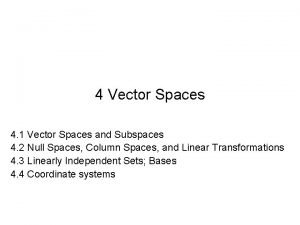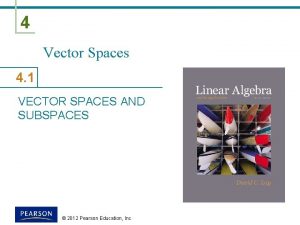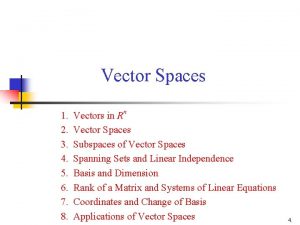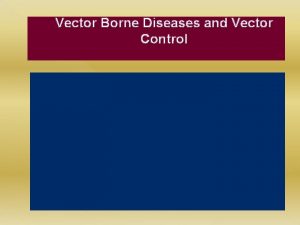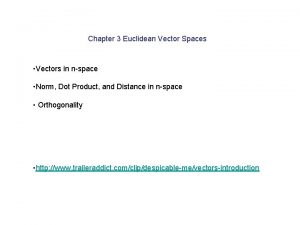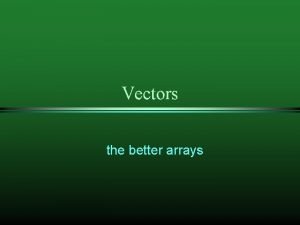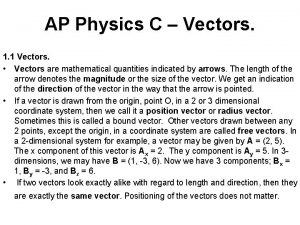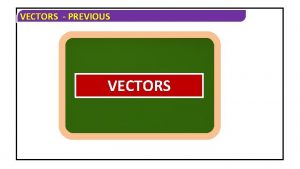Chapter 4 Vector Spaces 4 1 Vectors in





































![§ Notes: If rank([A|b])=rank(A), then the system Ax=b is consistent. 38 § Notes: If rank([A|b])=rank(A), then the system Ax=b is consistent. 38](https://slidetodoc.com/presentation_image_h/a90478eef3a0042e05f224aeb4cd2cc5/image-38.jpg)




![• Transition matrix from B' to B: If [v]B is the coordinate matrix • Transition matrix from B' to B: If [v]B is the coordinate matrix](https://slidetodoc.com/presentation_image_h/a90478eef3a0042e05f224aeb4cd2cc5/image-43.jpg)











- Slides: 54

Chapter 4 Vector Spaces 4. 1 Vectors in R n • An ordered n-tuple: a sequence of n real number § n-space: R n the set of all ordered n-tuple • Notes: n (1) An n-tuple can be viewed as a point in R with the xi’s as its coordinates. (2) An n-tuple can be viewed as a vector in Rn with the xi’s as its components. 1

• Ex: n=2 n=3 n=1 1 R = 1 -space = set of all real number 2 R = 2 -space = set of all ordered pair of real numbers 3 R = 3 -space = set of all ordered triple of real numbers n=4 4 R = 4 -space = set of all ordered quadruple of real numbers a point a vector 2

(two vectors in Rn) § Equal: if and only if § Vector addition (the sum of u and v): § Scalar multiplication (the scalar multiple of u by c): § Notes: The sum of two vectors and the scalar multiple of a vector n in R are called the standard operations in Rn. 3

§ Negative: § Difference: § Zero vector: § Notes: (1) The zero vector 0 in Rn is called the additive identity in Rn. (2) The vector –v is called the additive inverse of v. 4

5

6

§ Notes: A vector in can be viewed as: a 1×n row matrix (row vector): or a n× 1 column matrix (column vector): 7

• The matrix operations of addition and scalar multiplication give the same results as the corresponding vector representations Vector addition Scalar multiplication 8

4. 2 Vector Spaces • Notes: A vector space consists of four entities: a set of vectors, a set of scalars, and two operations 9

• Examples of vector spaces: (1) n-tuple space: Rn vector addition scalar multiplication (2) Matrix space: (the set of all m×n matrices with real values) Ex: :(m = n = 2) vector addition scalar multiplication 10

(3) n-th degree polynomial space: (the set of all real polynomials of degree n or less) (4) Function space: (the set of all real-valued continuous functions defined on the entire real line. ) 11

12

• Notes: To show that a set is not a vector space, you need only to find one axiom that is not satisfied. 13

4. 3 Subspaces of Vector Space § Definition of Subspace of a Vector Space: A nonempty subset W of a vector space V is called a subspace of V if W is itself a vector space under the operations of addition and scalar multiplication defined in V. § Trivial subspace: Every vector space V has at least two subspaces. (1) Zero vector space {0} is a subspace of V. (2) V is a subspace of V. 14

15

4. 4 Spanning Sets and Linear Independence 16

17

§ Notes: 18

§ Notes: 19

• Note: 20

21

22

23

4. 5 Basis and dimension § Notes: (1) the standard basis for R 3: {i, j, k} i = (1, 0, 0), j = (0, 1, 0), k = (0, 0, 1) n (2) the standard basis for R : {e 1, e 2, …, en} e 1=(1, 0, …, 0), e 2=(0, 1, …, 0), en=(0, 0, …, 1) Ex: R 4 {(1, 0, 0, 0), (0, 1, 0, 0), (0, 0, 1, 0), (0, 0, 0, 1)} 24

(3) the standard basis for m n matrix space: { Eij | 1 i m , 1 j n } Ex: matrix space: (4) the standard basis for polynomials Pn(x): {1, x, x 2, …, xn} Ex: P 3(x) {1, x, x 2, x 3} 25

26

27

• Ex: (1) Vector space Rn basis {e 1 , e 2 , , en} dim(Rn) = n (2) Vector space Mm n basis {Eij | 1 i m , 1 j n} dim(Mm n)=mn (3) Vector space Pn(x) basis {1, x, x 2, , xn} dim(Pn(x)) = n+1 (4) Vector space P(x) basis {1, x, x 2, } dim(P(x)) = 28

29

4. 6 Rank of a Matrix and System of Linear Equations § row vectors: § column vectors: Row vectors of A Column vectors of A || || (1) (2) A A || (n) A 30

• Notes: (1) The row space of a matrix is not changed by elementary row operations. (2) Elementary row operations can change the column space. 31

32

§ Notes: rank(AT) = rank(A) Pf: rank(AT) = dim(RS(AT)) = dim(CS(A)) = rank(A) 33

§ Notes: (1) The nullspace of A is also called the solution space of the homogeneous system Ax = 0. (2) nullity(A) = dim(NS(A)) 34

• Notes: (1) rank(A): The number of leading variables in the solution of Ax=0. (The number of nonzero rows in the row-echelon form of A) (2) nullity (A): The number of free variables in the solution of Ax = 0. 35

n Notes: If A is an m n matrix and rank(A) = r, then Fundamental Space Dimension RS(A)=CS(AT) r CS(A)=RS(AT) r NS(A) n–r NS(AT) m–r 36

37
![Notes If rankAbrankA then the system Axb is consistent 38 § Notes: If rank([A|b])=rank(A), then the system Ax=b is consistent. 38](https://slidetodoc.com/presentation_image_h/a90478eef3a0042e05f224aeb4cd2cc5/image-38.jpg)
§ Notes: If rank([A|b])=rank(A), then the system Ax=b is consistent. 38

39

4. 7 Coordinates and Change of Basis 40

• Change of basis problem: Given the coordinates of a vector relative to one basis B and want to find the coordinates relative to another basis B'. 41

§ Ex: (Change of basis) Consider two bases for a vector space V Let 42
![Transition matrix from B to B If vB is the coordinate matrix • Transition matrix from B' to B: If [v]B is the coordinate matrix](https://slidetodoc.com/presentation_image_h/a90478eef3a0042e05f224aeb4cd2cc5/image-43.jpg)
• Transition matrix from B' to B: If [v]B is the coordinate matrix of v relative to B [v]B‘ is the coordinate matrix of v relative to B' where is called the transition matrix from B' to B 43

44

n Notes: 45

46

4. 8 Applications of Vector Spaces 47

48

49

50

51

52

53

54
 Linear algebra chapter 4 solutions
Linear algebra chapter 4 solutions Dimensions of a vector space
Dimensions of a vector space Matlab vector of vectors
Matlab vector of vectors Matlab initialize vector
Matlab initialize vector Unit vector
Unit vector Vector unitario de un vector
Vector unitario de un vector How is vector resolution the opposite of vector addition
How is vector resolution the opposite of vector addition A position vector
A position vector Solve the vector product of 100j x 100k =?
Solve the vector product of 100j x 100k =? Chapter 3 vectors worksheets
Chapter 3 vectors worksheets A 100 lb weight hangs from two wires
A 100 lb weight hangs from two wires Chapter 12 vectors and the geometry of space solutions
Chapter 12 vectors and the geometry of space solutions This chapter shows how vectors can be added using
This chapter shows how vectors can be added using Twinspace.etwinning.net login
Twinspace.etwinning.net login Hardened magma squeezed into vertical spaces between rocks
Hardened magma squeezed into vertical spaces between rocks Brainstem dorsal view
Brainstem dorsal view What does ollie look like in small spaces
What does ollie look like in small spaces Spaces in primary dentition
Spaces in primary dentition Parapharyngeal space
Parapharyngeal space Fascial space of hand
Fascial space of hand Forearm space of parona boundaries
Forearm space of parona boundaries Predentate
Predentate Designing spaces for effective learning
Designing spaces for effective learning Sample complexity for finite hypothesis spaces
Sample complexity for finite hypothesis spaces Dental lamina
Dental lamina Hot potato voice
Hot potato voice Hilbert spaces
Hilbert spaces Spaces between particles of liquid
Spaces between particles of liquid Types of performance space
Types of performance space Enabling objectives
Enabling objectives Cummer classification
Cummer classification Ancillary spaces
Ancillary spaces Spaces cite multimedia
Spaces cite multimedia Qualcomm spaces apis unreal engine unityverge
Qualcomm spaces apis unreal engine unityverge New sacred spaces their
New sacred spaces their New yorkers spaces homes
New yorkers spaces homes Simple present progressive tense
Simple present progressive tense Backwards treble clef
Backwards treble clef Invited spaces of participation
Invited spaces of participation Halfspace intersection
Halfspace intersection Gross words a minute
Gross words a minute Croquis drawing
Croquis drawing Ansa cervicalis
Ansa cervicalis Area toracoabdominal limites
Area toracoabdominal limites Fill in the spaces using a or an
Fill in the spaces using a or an Carotid cana
Carotid cana Confined spaces
Confined spaces Confined spaces
Confined spaces Confined spaces
Confined spaces Difference between cave and cavern
Difference between cave and cavern The oval shaped symbols placed on staff
The oval shaped symbols placed on staff Tenor clef lines and spaces
Tenor clef lines and spaces Sample spaces
Sample spaces Posterior scapular region
Posterior scapular region Representing sample spaces
Representing sample spaces
